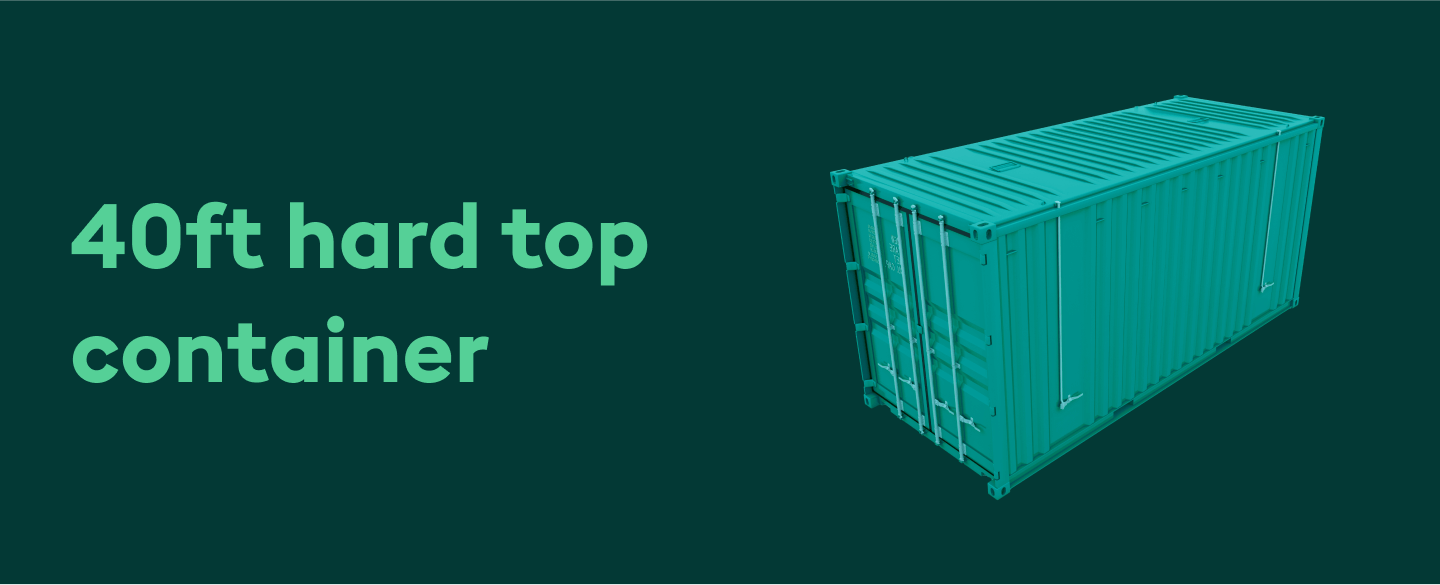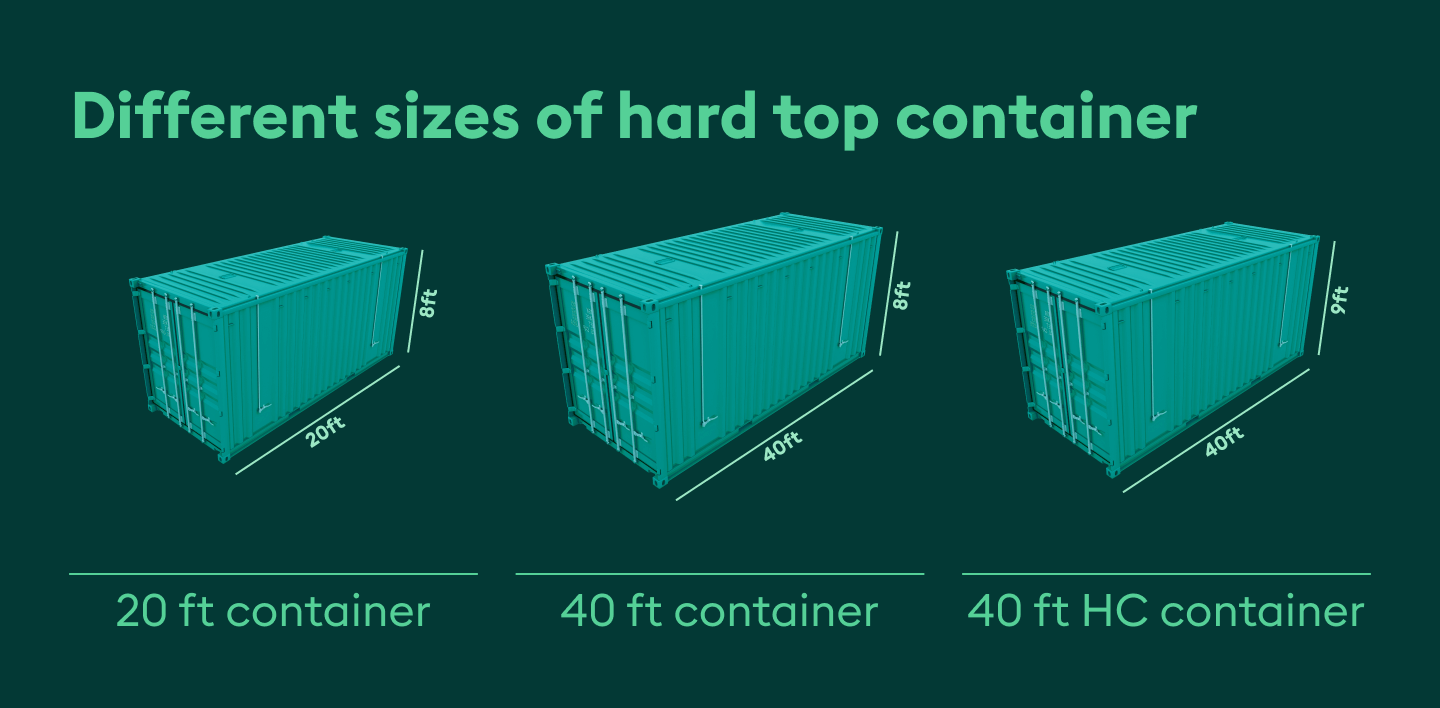The hard top container is one of the most versatile container types in the shipping world. Read this blog to find out all about hard top container sizes and uses. Plus, buy them at the best prices on the Container xChange platform.
Hard top containers are one of the most adaptable container types available. Designed for multi-purpose use, this special container type is ideal for dynamic industries. To put it simply, you can ship dry cargo as well as oversized and bulky cargo in a hard top container.
Now, when it comes to special containers, it can be tricky to get them from reliable suppliers and avoid being ripped off in the process. What’s more, many suppliers don’t have the specific containers you’re after when and where you need them. If these are some of the worries that keep you up at night, we’re about to make your day.
Welcome to Container xChange, an online container marketplace for buying, selling and leasing shipping containers of all kinds. We’ve got 50,000+ containers available in 2,500+ locations globally. What’s more, all suppliers on our platform are vetted and pre-approved. Finally, buy the containers you need safely, at prices that suit you.
If you want to get a sneak peek of our platform and learn more about how it works, try out our public search right now. Simply type in your location, plus the container type you’re after to see all hard top container offers that match your criteria today.
What is a hard top container?
Hard top containers are special containers that come with a removable roof. Structurally, they’re similar to a standard dry container. However, the removable roof makes this container type suitable for shipping heavy, oversized, and oddly-shaped cargo that needs to be loaded from the top.
Hard top shipping containers come in three main sizes: 20ft, 40ft and 40ft high cube.
Characteristics of hard top containers
We know that the hard top container is perfect for shipping both general dry goods and special cargo. Now, let’s take a look at a few of the features that make this container type so versatile.
Like all containers, hard tops are made of corrugated steel. The floor is made of wood to reduce friction. Most hard top containers have rings on the roof so that the top can easily be removed with a forklift. The weight of the roof is approximately 450 kg.
You also don’t need to worry about securing the cargo inside the container. Hard tops have lashing rings installed on the upper and lower side rails, corner posts (which can handle up to a 2000 kg load), and middle of the sidewalls (with a 500 kg load handling capacity). This only applies if the roof of the container is closed.
Another important feature of the hard top container is that the door header pivots outside. This makes it easy to load and unload cargo using a forklift.
How hard top containers are used as open top containers
The best part about hard top containers? In cases where cargo is taller than the container itself, the detachable roof is simply removed and lashed onto a sidewall inside the container. Now it’s an open top container!
Usually, freight-forwarders and NVOCCs specializing in transporting multi-purpose cargo invest in hard top containers. They can use these containers as standard or open top containers — depending on the requirements of their customers.
Similarly, manufacturing industries importing raw materials and exporting finished goods use hard-top containers to transport a wide variety of cargo.
Sizes and dimensions of hard top containers
Containers are made according to standard sizes set by the International Organization for Standardization (ISO). As we mentioned above, hard tops come in three main sizes. Let’s get into more detail on each size, its dimensions and uses now.
20ft hard top container
The 20ft hard top container functions similarly to a standard TEU. Opt for a 20ft hard top container if you’ve got smaller shipments of dry goods or out-of-gauge cargo. The 20ft is perfect for shippers looking to invest in hard top containers at a lower price range.
| Measure | 20ft high top |
| Internal length | 5.89 m / 19.3 ft |
| Internal width | 2.34 m / 7.8 ft |
| Internal height | 2.38 m / 7.9 ft |
| Tare weight | 2,700 kg / 5,950 lbs |
| Payload capacity | 27,780 kg / 61,244 lbs |
| Cubic capacity | 33.0 m3 / 1,165 ft3 |
40’ hard top container
The 40ft hard top container is twice the size of the 20ft hard top. Use this hard top size for bulky and high-volume cargo. 40ft hard tops containers also offer good value-for-money, especially considering they’re usually only around 30% more expensive than the 20ft variety.
| Measure | 40ft high top |
| Internal length | 12.03 m / 39.5 ft |
| Internal width | 2.34 m / 7.8 ft |
| Internal height | 2.38 m / 7.9 ft |
| Tare weight | 4,700 kg / 10,362 lbs |
| Payload capacity | 27,300 kg / 60,180 lbs |
| Cubic capacity | 65.3 m3 / 2,306 ft3 |
40 high cube hard top container
The 40ft HC hard top container has an additional foot of height to the 40ft hard top. These spacious containers are ideal for damage-free shipping of large shipments. They’ll also offer you the best storage value for your money.
| Measure | 40ft high cube container |
| Internal length | 12.03 m / 39.5 ft |
| Internal width | 2.34 m / 7.8 ft |
| Internal height | 2.69 m / 8.9 ft |
| Tare weight | 5,200 kg / 11,470 lbs |
| Payload capacity | 28,600 kg / 63,052 lbs |
| Cubic capacity | 76.3 m3 / 2,694 ft3 |
What type of cargo is shipped in a hard top container?
To answer this question, we have to go back and look at its main feature: the detachable roof. If the roof is attached, you can use this container type to transport all types of dry cargo including grains, paper, clothing and electronics. And if it’s detached, use this container to ship bulk cargo like cement, construction goods like steel, large machinery, and more.
Hard top containers are especially useful for heavy goods and out-of-gauge cargo which needs to be loaded through the roof using a forklift or crane. Cargo commonly transported in hard top containers includes marble, glass sheets, raw materials like coal and construction machinery.
In terms of pallets, you can also easily fit 25 to 30 pallets (American or European) inside this container type. The exact number of pallets will depend on the container size of course.
What is the price of a hard top shipping container?
Now that you know about the different sizes of hard top containers, you must be wondering about the average prices. Like any other special containers, expect hard tops to be on the pricer side.
But if you look at its dual function as an open top container and a standard container, it might be the best financial decision you’ll make at its price point. Let’s look at the price for a 20ft cargo-worthy hard top, open top and standard dry container below:
| Price of 20ft cargo-worthy containers in Northern Europe (USD) | ||
| Hard top | Open top | Dry container |
| $5,000 | $3,570 | $1,540 |
How hard top containers are cheaper than open tops & dry containers
Now, at first glance, a 20ft hard top container looks more expensive than other container types. But don’t forget that at US $5,000, you get a container that can be used as both an open top and a dry container.
If you were to buy an open top and dry container separately, you’d have to spend US $3,570 + US $1,540 = US $5,110. That’s an additional amount of US $110. Why spend more money when you can get the best of two containers all-in-one?
So, hard top containers are not only one of the best functional buys but also an economical one. Please note that the average price of containers varies from location to location. It’s best to do your research and compare prices before investing in shipping containers of any kind.
Want to buy hard top containers and get two container types in one? Browse hard top container offers in 2,500+ locations on xChange right now, and find the best deal for your budget today.
Buy & lease hard top containers at the best price on Container xChange
As you’ve seen, hard top containers are one of the best buys in the container industry. No wonder freight-forwarders and shippers are always on the hunt for them! But this also makes it difficult to source them at prices that suit your budget.
Luckily, we have a solution for this. On our online container marketplace, we have 50,000+ containers available in 2500+ locations worldwide. Once you enter your requirement, you’ll receive container offers from sellers and lessors in one dashboard. You can compare these offers, including the prices, and select the one that best fits your needs.
What’s more, you can negotiate the prices of containers directly with the supplier. You heard that right! No fuss, no middlemen, and no sneaky added fees.
Over 1,500 members use our platform to buy, lease, and sell containers globally. And don’t worry — all members undergo a thorough background check to make the experience safe and secure for everyone involved. So rest assured you’ll sign only genuine deals from our trusted network!
Here are some of the benefits you’ll enjoy as a member on the xChange platform:
- Get notified about the best offers according to your needs
- 0% commission and no added fees
- Make safe and secure payments using the xChange Wallet
- Work with only vetted and pre-approved partners
- Negotiate prices and leasing rates to get the best deals for your budget
All this with no hidden costs or added commission on deals. Ready to get started today? Click on the banner below to get your free tour of our trading and leasing marketplaces. Our team of experts will answer all your queries and tell you exactly how the platform can work for you. Just think, you’ll be buying hard top containers at the best price for your budget in no time at all.
Hard top container: Common FAQs
What’s a hard top container?
A hard top container is a specialized standard dry container with a removable roof. This container type is suitable for shipping heavy, oversized and oddly-shaped dry cargo. Hard tops come in three main sizes; 20ft, 40ft and 40ft high cube.
What is an open top container?
An open top container is a special intermodal container with a convertible top made of tarpaulin sheet. It's ideal for shipping oversized or bulky cargo that can’t be loaded through standard container doors.
What’s the difference between an open top and a hard top container?
An open top container has no roof, and is often covered with a tarpaulin to protect goods from the elements. A hard top, on the other hand, has a hard, detachable roof.





